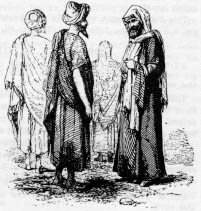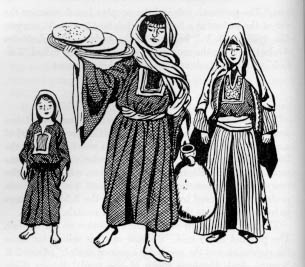
Cloth discovered from biblical times
Costumes
The Ancient Hebrews of Biblical times were very resourceful and creative in their manner of dress, both in the types of material produced and their design of clothing as a whole. Hebrew women had many different sources of fiber with which to work. There was easy access to vegetable fibers, such as flax and cotton, which were grown in Egypt and imported into the Near East. Animal fibers, such as wool, were also used in the production of cloth and could be commonly found in Israel. Linen and cotton were usually used in their natural states. Wool on the other hand, which came in a variety of shades according to the color of the sheep was used within the natural colorings but was often dyed as well. The prominent colors were brown, tan, reddish, and yellow, with stripes of black, green, blue, and various other shades.

Cloth discovered from biblical times

Egyptian Style Clothing
There were three basic articles that were worn by both genders during the Biblical era. The first piece of clothing was called the tunic or the inner garment, and was most commonly made from linen.

Tunic
The next layer of clothing was called the outer garment, which appropriately was worn on the outside. This article was a piece of square cloth that was wrapped around the body or tied over the shoulders. According to Jewish law, each corner was to be fringed, together with a blue cord to remind them of the commandments.

Biblical every day garments
The third main article of attire was called the girdle. Each individual generally had two, one worn on the inside over the tunic and the other was worn over the outer garment to allow free movement. There were two types of girdles, depending on your status in life. The most common type was about six inches across, made of leather, and fastened together on the ends with clasps. The second type, which was more valuable, was made of linen, silk, or embroidered material. It could be wrapped around the waist two to three times and was only about a hands width across. A girdle was made by folding the material in half and then sewing the ends together, thus forming a type of pouch. This pouch could be used as a change purse, which was safe and convenient. It also was used to fasten swords and other objects to the body.
Although both genders shared these common articles of similar form and fashion, there were several important differences in dress. The one very distinguishing difference between men and women was that women wore veils of various lengths and types when in public. All women wore them except for maidservants and women of low positions in life. Their clothes were generally of a finer quality and longer in length than the males. They also braided their hair, wore make-up, and jewelry which all set them apart from the men in appearance.

Jewish women in biblical times
Major differences are also found between the rich and the poor as well as the genders. For example, on festival days, the upper-class would wear white cotton. Purple clothing was worn by kings and princes when appearing in state and was considered more precious then gold. The lower ranks clothes were plain and cheap, being made of mainly wool and flax, or even coarse hair-cloth. The rich, besides having higher quality of clothing, also would wear garments of different names and forms then those used by the rest of the general population of the country. The age or the ill often were given extra layers as well.
Another article of clothing the Hebrews wore was footwear. There were two types, sandals and shoes. Sandals were worn by the vast majority, being the cheapest means of wear. They were constructed of a wooden or hide sole, and fastened with leather thongs or straps. Shoes were worn only by the rich and then in slightly later years by fashionable ladies, who added to them a great deal of adornment and expense.
|
Sandals |
Shoes |
The ancient Hebrews were advanced in the types of materials and skills necessary in the production of cloth and design. They were capable of producing many of the same types of items that we produce today, just at a slower rate. Their styles vary tremendously from the modern Western world, but are relatively similar to some of those in Eastern countries today. For the resources that were available, the Biblical Hebrews creatively and with skill accomplished a unique and wonderful fashion.
We would like to thank http://webstu.messiah.edu/~ls1185/home.htm for the information and pictures presented on this page.